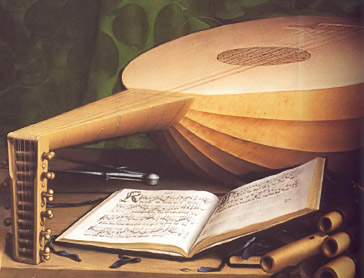
LUTE CAMERATA
LEVEL FIVE
home
Level one: A good sound. Know what they knew, and practice. Tuning. Simple pieces, basic technique. Beginning notation. Throw away your solo CDs.
Level two: books of songs; simple scores, two clefs. Jack & Joan. Simple pieces and songs from both Tab and keyboard notation. The grand rotation.
Level three: basic singing, basic sight-reading; intermediate musicianship.
Level Four: The art of accompanying. Ensemble skills. Medium to high difficulty part songs.
Level five: the great solos and real renaissance ornaments; complex scores, clefs. Different Tab versions, singing from TAB. Arranging. The art of orchestra playing. Advanced rhythms such as late 14th century music and pieces by Tye and Baldwin.
Level Six: True professional, thorough knowledge of the middle ages, renaissance and baroque. All clefs. Al scores. All solos. All songs.
Still under construction. To be completed August 2007 Level Six: Reaching potential |
Currently, there are no players today at level six. However, we know that it is possible to easily reach level six because there are several players who have almost all the skills required. Repertory: The Level Six player can play the really tough pieces smoothly--Bakfark, Jannequin and Weiss, to name but a few. Ornamentation: this player can do all the ornamnents in different styles, Ganassi, Bassano, Ortiz, etc.,as the cornetto and recorder players can now do. Musicianship: An advanced level of musicianship including all of the clefs, sightsinging, basic keyboard & keyboard harmony, dictation of bach chorales, etc. Also, the ability to hearchord played on the keyboard and play it back without being told the figures. Advanced ensemble skills iclude the ability to play pieces such as Matheus de Perusio's Le Greygnour Bien, as well as "Sit Fast" by Tye. Hexachord studies: The ability to sightsing using historical models of hexachord transformation. Notation: the equivalent of one year minimum paleography including the ability to read any piece in original notation from the Ogni Sorte Editions (these are not the hardest, but hard enough). The ability to accompany a voice class from sight. The ability to read any lute song from keyboard notation, and transpose a basic rendition up or down a tone, and down a fourth. Accurately render the three instrumental parts of any tenor lied in clefs, e.g., Innsbuck ich muss dich lassen. All the basic chords in all inversions in all the keys, including sevenths, with alternate positions to avoid parallels. All the major and minor scales, all the hexachords, all the modes, evenly and in octaves, parallel sixths, parallel thirds. Scores: This player can easily play Handel Operas & the Bach Matthew Passion without a lot of parallels and wrong chords. Scores in clefs: In addition to the above, this player can play from scores in *real* clefs, including the Rameau Operas which often have multiple figures on a bassline in Baritone Clef. Languages: Minimum fluency in two foreign langiages plus the ability to correctly translate a simple treatise, such as Capirola or Caccini. |